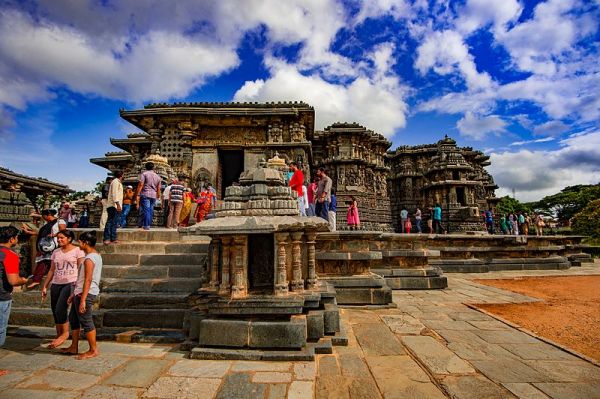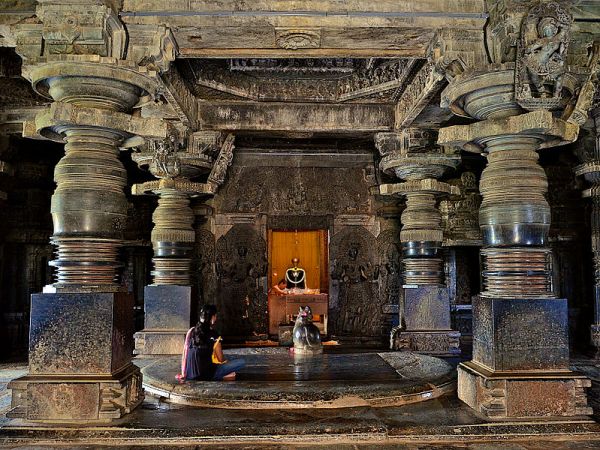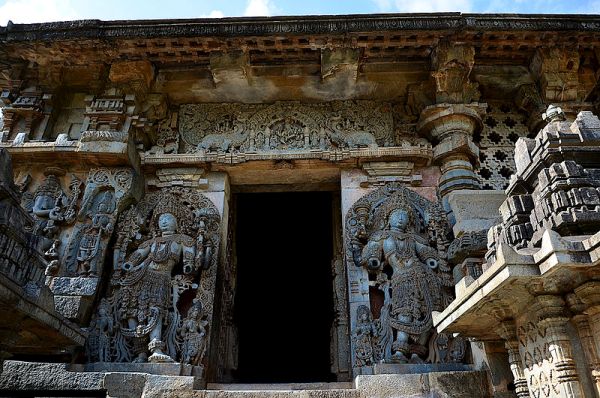Hoysaleswara Temple Halebeedu
About Hoysaleswara Temple
Hoysaleswara temple is a temple dedicated to Hindu god Shiva. It was built in Halebidu (in modern Karnataka state, India) during the rule of King Vishnuvardhana of the Hoysala Empire in the 12th century. The construction was started around 1120 CE and completed in 1150 CE. During the early 14th century, Halebidu was sacked and looted by Muslim invaders from northern India and the temple fell into a state of ruin and neglect. Previously known as Dorasamudra or Dwarasamudra, Halebidu is 16 km from Belur, 31 km from Hassan and 149 km from Mysore, in the state of Karnataka, India.
According to art critic and historian S. Settar, from contemporary inscriptions it is known that the temple derives its name from the Hoysala ruler at that time, King VishnuvardhanaHoysaleswara, though interestingly, the construction of the temple was initiated and financed by wealthy Shaiva (a Hindu sect) citizens of the city, prominent among who were Ketamala and Kesarasetti. The temple building activity was taken up in competition to the construction of the Chennakesava Temple at Belur, a Vaishnava (a Hindu sect) temple. Surrounded by numerous tanks, ponds and mantapas, the temple is built in the vicinity of the large Dorasamudhra lake. The tank preceded the temple by nearly 75 years. It is one of the largest temples dedicated to the god Shiva in South India.
The temple is a simple dvikutavimana (plan with two shrines and two superstructures), one for "Hoysaleswara" (the king) and the other for "Shantaleswara" (named after Shantala Devi, queen of King Vishnuvardhana) and is built with chloriticchist (more commonly known as Soapstone or potstone). The temple complex as a whole is elevated on a jagati (platform), which according to historian Kamath, is a feature that became popular in contemporary Hoysala constructions. According to art historian Foekema, the two shrines which are adjoining, face east and each have a mantapa (hall) in front. The two mantapas are connected giving a large and imposing view of the hall. Individually, each shrine is smaller than the one at the Chennakesava Temple at Belur and contains a simple linga, the universal symbol of the god Shiva. The plan of the inside of the temple is simple but the exterior looks different because of the introduction of many projections and recesses in the walls. The towers of the shrines that are missing must have followed the star shape of the shrine, just as in many existing well-preserved towers in other Hoysala temples. The superstructure over the vestibule which connects the shrine to the mantapa, called sukanasi (a low tower that looks like an extension of the main tower), and the row of decorated miniature roofs above the eaves of the hall are all missing. The temple was built at a height that provided the architects sufficient horizontal and vertical space to depict large and small sculptures. According to the art critic James Fergusson, the overall effect of the vertical and horizontal lines, the play of the outline, the effect of light and shade and the plan of the projections and recesses all amounts to a "marvellous exhibition of human labor to be found even in the patient east and surpasses anything in Gothic art". The outer walls of these temples contain an intricate array of stone sculptures. The temple of Halebidu, has been described by art critics James Fergusson and Percy Brown as an "outstanding example of Hindu architecture" and as the "supreme climax of Indian architecture".
The temple has four porches for entry and the one normally used by visitors as main entry is actually a lateral entrance (north). There is one entry on the south side and two on the east side, facing two large detached open pavilions whose ceiling is supported by lathe turned pillars. All entry porches have miniature shrines as flanking. In addition there is a sanctuary for the Sun god Surya, whose image stands 7 ft (2.1 m) tall. The pavilions enshrine large images of Nandi, the bull, an attendant of Shiva. The pavilions share the same jagati as the main temple. As in the Chennakesava temple, this temple originally had an open mantapa to which outer walls with pierced window screens made with the same material were erected, making the mantapa a closed one. The window screens are devoid of any art work. The interior of the temple is quite plain except for the lathe turned pillars that run in rows between the north and south entrances. According to Settar, the four pillars in front of each shrine are the most ornate and the only ones that have the madanika (chaste maidens) sculptures in their pillar brackets. There are no other madanikas in the temple.
By Rail: The state is connected to all parts of the country by rail. It is easiest to get a connection to Bangalore and from here you can easily reach other parts of the state.
By Road: The border of Karnataka linked to Maharashtra and Goa in the north, Andhra Pradesh in the north east, Tamil Nadu in the southeast and Kerala to the southwest. There are many entry points from all of these states, and interstate buses are frequently run by the government and private coach services at cost effective rates. You can also hire a cab or rent a car at explore this captivating tourist destination.Find detailed information about how to reach Karnataka by Train, Bus, air, flight timing and schedule. Read reviews, details to know how to reach Karnataka & get information about Karnataka.
- Hotel KRS cauvery.
- Hotel nandi hills.
- Lalbagh
- Mysore palace.
- Cubbon Park.
-
-



